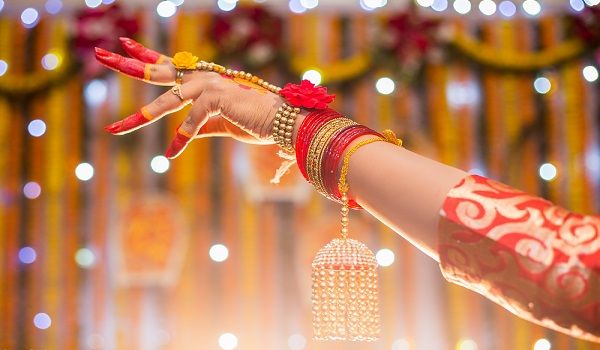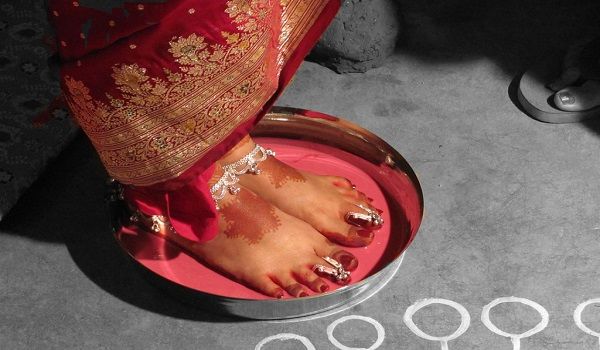
Image Source: Wikipedia.org
A Bengali Wedding often referred to as ‘Biye ’is quite a visual treat. A host of deep, meaningful rituals seeped in culture and tradition are performed amidst riot of colourfully elegant and immensely creative decorations. The Bengali weddings are celebrations of colour, camaraderie and beauty above all else. They forgo the showing off, keeping the roots firmly on traditional elements. They are elaborate affairs with celebrations spanning for 2-3 days from morning till night. The rituals and their executions are subtly different among the two main subcultures in Bengal, the Bangals (Bengali Hindus originating from modern day Bangladesh) and the Ghotis (the ones originating in West Bengal). To know more about Bengali wedding ceremony, follow the post.
Pre-Wedding Rituals
Paka Katha or Pati Potro–This ritual refers to a formal meeting between the elders of the bride’s and groom’s families to formally agree on the different facets of the marriage. Paka Dekha is the term used by the Ghotis while Pati Potro happens among the Bangals.
Aiburobhat– This is sort of a version of Bridal shower which takes place on the afternoon or night before the wedding day. Generally, close friends and relatives gather at the bride’s house and shower her with gifts. Then she is treated to an elaborate feast with rice, fish and several vegetable dishes. This is said to be her last meal as a spinster. A similar ritual is observed at the groom’s place where he takes his last meal as a bachelor.
Sankha Porano – In some traditions the bride is made to wear traditional Bengali symbols of marital bliss, the Sankha which is bangle made from Conch Shells, and Pola Bangles made from red Corals, on the evening before the wedding day.
Jol Sowa–On the morning of the wedding day, mother of the bride and groom is accompanied by few married women of the family to the nearest water body to fill a brass pitcher in their respective neighbourhood. This water is to be used to bathe the bride or groom after their Gaye Holud ceremony.
Dodhi Mangal – The bride and the groom are fed with a mixture made of sweet curd, rice flakes, banana and sweets like sandesh in copious quantity before sunrise. This is their last meal of the day as they would have to fast until the wedding rituals are complete.
Birddhi Puja– The father or other male relative of both bride and groom perform this ritual in their respective homes. Sanskrit hymns are chanted and offering are made to the past seven generations of paternal ancestor to appease their souls and seek their blessings.
Gaye Holud and Tattwa–A turmeric paste made from grinding fresh turmeric with mustard oil is applied on the groom’s body by his mother and other married female relatives. He is then bathed with the water procured in the morning. The remaining turmeric paste is put in a silver bowl and sent to the bride’s place along with her entire trousseau a simple outfit to be worn during the Gaye Holud and a whole Rohu fish. The Gaye Holud is then performed at the bride’s place in a similar fashion to the grooms.
After Gaye Holud, the bride proceeds to get ready for the Wedding Day evening.
Wedding Attire
The Bengali groom typically wears a Kurta, which is known as Panjabi, with a Dhoti. While the Panjabi may be made from various materials like, Cotton, Silk or Tussar, the Dhoti is generally made of Muslin or Bengal Handloom known as Tant. The Panjabi features gold or sometimes diamond studded buttons. The groom wears dots of sandal wood paste on his forehead. He also features a conical head adornment known as the ‘Topor’ that is made of Shola or Indian Cork. He also wears a garland made of tuberoses and roses. When he participates in the wedding he is to change into fine silk two piece attire known as the ‘Jor’. The groom is to carry a round brass object with long handle known as the ‘Darpan’ at all times.
The attire of the Bengali bride is one of the most regal and elegant that transforms her into a Goddess. She usually wears a Red Benarasi Saree made of silk and heavily embroidered with gold zari threads. It may be drape in different way, but the ‘aath poure’ style is traditionally Bengali. She wears a veil to cover her head and a lot of jewellery. The quintessential Bengali artistic sensibilities are evident on the unique designs drawn on the bride’s forehead with kumkum and sandalwood paste centring on that big red bindi. She also has to wear a complimentary headgear to the groom’s topor, known as Mukut. The Bengali bride has to carry an ornate wooden container filled with sindoor and a one rupee coin known as the ‘Gachh Kouto’. In some customs, she also needs to carry a ‘Kajal Lata’, an oblong or eye-shaped flat metallic container carrying Kohl paste.
Wedding Rituals
Bor Jatri and Boron–The groom starts from his house after receiving his mother’s blessings, in a specially decorated car sent by the bride’s family, towards the wedding venue, accompanied by few of his friends and elderly male relatives. These people accompanying the groom or Bor are known as Bor Jatri. Upon reaching the wedding venue, the Groom and the Bor Jatri are received with much enthusiasm amidst blowing of conch shells and ululations. The mother of the bride welcomes him with a Baran Dala, a large tray made of cane containing auspicious ingredients like rice, turmeric, betel nuts, bunch of banana and a lighted diya. She touches it to the groom’s forehead, then shoulders and then the chest and repeats this thrice. She then feeds him with sweets and water and ushers him in.
Ashirbaad– The elders from bride’s side take their turns in blessing the groom and presenting him with expensive gifts of jewellery, cash or even watches. The same procedure is repeated by the elders accompanying the groom with the bride where they bless her and present her with pieces of jewellery.
Saat Paak and Subho Drishti– The groom is brought into the wedding mandap known as Chhadnatolla and an initial puja is performed along with the person who will do the Kanya Sampradan. The groom is then asked to change into his Jor. After he is back to mandap, the bride is seated in a wooden platform known as piri and is carried by 4-5 young male members of her family to the mandap, all the while she hides her face from view with the help of a couple of betel leaves. The bride is supposed to circumambulate around the groom seven times aided by the male relatives carrying her. This is known as Saat Paak. The bride and groom are then placed in front of each other. The bride removes the betel leaves and the two set their eyes on each other, amidst hooting, and sounds of conch shells and ululations. This is known as Subho Drishti.
Mala Badal– The couple then exchange their garland in a ritual known as Mala Bodol. A fun element is added when the relatives of both bride and the groom hoist them up to make it difficult to reach. A lot of competitive fun and laughter ensues.
Kanya Sampradan– The bride is then brought into the Chhadnatolla, where she is seated opposite to the groom and an elderly male member of the bride’s family unite their hands and it is bound by sacred thread, and the priest chants the mantras whereby the bride is officially given away to the groom.
Hom– The bride and the groom then sit beside each other in front of the sacred fire while the priest utters Vedic mantras which they dutifully repeat after. All the while they have to periodically make offerings to the fire after the verses end.
Saptapadi– The priest ties a knot between the end of the bride’s saree and the grooms shawl. The couple then have to go around the fire seven times, while uttering the seven sacred vows.
Lajanjali/Kusumdinge– The bride’s brother puts puffed rice into her hands, the groom joins her hands from behind and together they pour the offering in the fire.
Sindoor Daan– Next the groom applies Sindoor on the parting of bride’s hair and he covers her head with a new saree known as the Lajjabastra.
Post-Wedding Rituals
Basar Ghar – After the wedding is completed; the bride and groom are seated together along with other members of the bride’s family and a lot of teasing and laughter ensues.
Bashi Biye–Among the eangali Community, the Kusukdinge and Sindoor daan rituals take place on the morning of the day after the wedding. This is known as the Bashi Biye. The bride and the groom get ready in their wedding finery to participate in the ritual.
Bidaai– Bidaai refers to the departure of the couple from the bride’s place. It is mostly a tearful and emotional event. The bride throws handful of rice over her shoulder into her mother’s outstretched hands. Among the Ghoti community the couple departs on the morning time while the Bangal rituals dictate that the couple leave before evening.

Bodhu Baran– The bride is welcomed into her in-laws’ place. Water is poured under the vehicle, a vessel containing milk and lac dye or alta is placed outside the door and the bride needs to step into it and the imprint of her feet are put on white fabric. She has to hold a live fish and look and a boiling bowl of milk for prosperity of the house. She is then blessed by the elders of the house with cash and jewellery as gifts.
Kaal Ratri– The night the bride comes into her husband’s house, the couple are not allowed to meet each other and are put up in separate rooms.
Bou Bhaat – The next day morning, the bride is initiated officially into the new family during the Bou Bhaat ritual. The husband presents his wife with clothes and sweets on a platters and promises to take care of her for the rest of their lives. Then she offers the members of the family rice and ghee during mealtime.
Reception – That evening the groom’s family invites their relatives for a reception where they get to meet the new bride and offer their best wishes to the couple.
Phul Sojja–The couple’s bedroom is decorated with colourful flowers and the couple spend their first night together.
Diragaman/Astamangala/SubhoChani Satyanarayan Pujo– On the eighth day of the wedding the couple visits the bride’s place. A Satyanarayan puja is performed and the thread tied during the wedding is removed by the priest.




